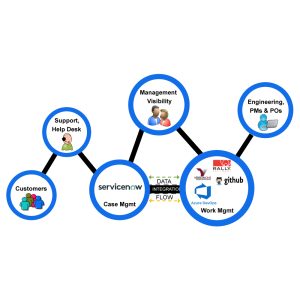Why Environmental Intelligence Matters Today?
Environmental, Social, and Governance (ESG) reporting is no longer a corporate checkbox—it is now a strategic imperative. In an age of rising climate risks, investor scrutiny, and regulatory pressure, organizations are under immense pressure to track, disclose, and act on their environmental performance. As a result, Environmental Intelligence (EI) has emerged as a vital discipline for data-driven sustainability.
Environmental Intelligence integrates weather forecasting, climate modeling, carbon accounting, and asset risk insights into actionable strategies. It enables businesses to identify risks, respond to disruptions, and achieve sustainability targets while maintaining operational resilience.
IBM is at the forefront of this transformation with its two flagship offerings: IBM Environmental Intelligence Suite and the IBM Envizi ESG Suite. Together, these tools deliver a unified, AI-powered approach to sustainability, compliance, and performance optimization.
In this comprehensive guide, we explore the top IBM solutions enabling environmental intelligence and ESG excellence—and how IBM Solution Partners like Nexright help organizations operationalize them.
1. What is Environmental Intelligence?
Environmental Intelligence (EI) is the application of advanced technologies—such as artificial intelligence (AI), the Internet of Things (IoT), geospatial analytics, and big data—to capture and interpret environmental data for informed decision-making. At its core, EI enables the real-time integration of various data sources, including weather patterns, emission levels, climate models, and supply chain activity, to generate predictive insights and timely alerts.
This intelligence is especially critical for organizations navigating complex climate-related risks. From floods and wildfires to regulatory carbon targets and biodiversity loss, environmental disruptions can severely impact operations, infrastructure, and long-term viability. EI empowers enterprises to anticipate these risks early, understand their impact on assets and operations, and take proactive steps to mitigate them.
Beyond risk management, Environmental Intelligence plays a transformative role in ESG (Environmental, Social, and Governance) transparency. By delivering accurate, timely environmental data, organizations can better meet compliance standards, demonstrate sustainability progress to stakeholders, and make data-driven choices that align with both business goals and planetary well-being.
2. The Rising Importance of ESG in Business Strategy
The rise of ESG (Environmental, Social, and Governance) in corporate strategy reflects a fundamental shift in how value is defined and measured. No longer viewed as a set of soft goals or public relations tactics, ESG is now recognized as a framework for long-term resilience, investor confidence, and operational excellence. Institutional investors, rating agencies, regulatory bodies, and even consumers increasingly demand that companies prove their commitment to sustainability and ethical governance—through measurable, auditable data.
In response, companies are expected to go beyond basic disclosures. They must now report on a wide array of metrics, including Scope 1, 2, and 3 greenhouse gas emissions; water usage; energy intensity; and overall resource efficiency. Social metrics like workforce diversity, equity, inclusion (DEI), employee well-being, and community impact are gaining prominence. Governance factors—such as board diversity, executive compensation, anti-corruption policies, and cybersecurity—are also under scrutiny. Failing to address these pillars can lead to reputational damage, limited capital access, and regulatory penalties.
Yet, producing accurate and timely ESG reports is no small feat. The data often resides in fragmented systems, across global operations, or with third-party vendors. Manual reporting increases the risk of error and inconsistency. This is why businesses are turning to enterprise-grade digital platforms like those from IBM. With automation, AI, and centralized data management, companies can collect, normalize, and report ESG data at scale—ensuring compliance while gaining insights that drive better decisions and long-term value creation.
3. IBM’s Vision for a Sustainable Future
IBM envisions a future where environmental and climate risks are treated with the same rigor and foresight as financial risks. In a world increasingly shaped by climate change, resource scarcity, and shifting regulations, IBM recognizes that businesses need real-time, data-driven insights to remain competitive and compliant. To meet this need, IBM has placed sustainability at the core of its product innovation, delivering environmental intelligence solutions that are as strategic as they are technical.
These solutions are powered by a robust foundation of artificial intelligence, hybrid cloud, and enterprise data platforms. IBM uses AI to predict environmental disruptions, identify sustainability opportunities, and automate ESG data collection across business units and ecosystems. Cloud-native deployment ensures flexibility and scalability, while the IBM Cloud Pak for Data and IBM Maximo platforms offer seamless integration with existing enterprise infrastructure.
To further its sustainability mission, IBM has strategically acquired tools like Envizi—a market-leading ESG performance management platform—allowing clients to connect sustainability data with operational and financial performance. Combined with years of investment in asset-intensive platforms like IBM Maximo, IBM now offers a complete, end-to-end ESG toolkit. From emissions tracking and real-time risk analysis to compliance reporting and supply chain optimization, IBM equips organizations with the technology, insights, and support needed to accelerate their sustainability transformation.
4. Overview of IBM Environmental Intelligence Suite
The IBM Environmental Intelligence Suite (EIS) is an AI-powered software-as-a-service (SaaS) platform specifically designed to help organizations manage environmental risks and sustainability performance with precision and foresight. Built on decades of IBM’s leadership in weather forecasting, asset management, and geospatial analytics, the suite enables businesses to turn complex environmental data into actionable insights.
At its core, IBM EIS integrates a range of critical data sources—including hyperlocal weather forecasts, satellite imagery, IoT sensor streams, and climate models—and transforms them into visual dashboards and automated workflows. This holistic approach gives decision-makers the tools to monitor conditions in real time, simulate future environmental impacts, and act quickly to protect people, infrastructure, and operations.
The solution is particularly valuable for operational leaders in industries like energy, transportation, manufacturing, and agriculture, where extreme weather and environmental volatility can disrupt supply chains, damage assets, and endanger compliance. Whether the threat is a looming wildfire, a heatwave affecting power grids, or regulatory mandates on carbon intensity, IBM’s Environmental Intelligence Suite offers the predictive intelligence and operational agility organizations need to stay ahead. It not only supports disaster preparedness but also helps embed sustainability into daily operations—making environmental resilience a core business capability.
5. Key Features of IBM Environmental Intelligence Suite
- AI-Driven Climate Risk Modeling: Leverages predictive analytics and asset geolocation to simulate climate scenarios. Helps businesses forecast threats and evaluate impact. Supports long-term environmental planning.
- Severe Weather Alerts: Delivers hyper-local, real-time notifications for floods, wildfires, hurricanes, and more. Alerts are asset-specific and automated. Enables faster incident response and continuity planning.
- Geospatial Mapping: Offers interactive visualizations of weather events, emissions, and infrastructure data. Combines satellite, IoT, and GIS sources. Empowers location-based decision-making across teams.
- Custom Rule Engine: Allows businesses to define environmental thresholds and automate workflows. Can trigger alerts, reports, or operational procedures. Helps align environmental events with risk policies.
- Asset Impact Forecasting: Integrates with IBM Maximo to predict how assets may be affected by climate risks. Supports preventive maintenance and risk prioritization. Reduces downtime and costly damage.
- Carbon Tracking Dashboards: Tracks GHG emissions across departments, facilities, or regions. Provides detailed insights for compliance and ESG reporting. Enables organizations to meet sustainability targets.
6. Overview of IBM Envizi ESG Suite
The IBM Envizi ESG Suite is a comprehensive sustainability performance management platform. It helps organizations automate the collection, analysis, and reporting of ESG data. It is particularly strong in carbon accounting, utility management, and ESG disclosure alignment.
Envizi supports key frameworks like:
- TCFD (Task Force on Climate-related Financial Disclosures)
- CDP (Carbon Disclosure Project)
- SASB, GRI, and CSRD reporting
- Scope 1, 2, and 3 emissions tracking
7. Core Capabilities of IBM Envizi
- Automated Data Ingestion: Seamlessly collects utility bills, asset performance metrics, and supplier data. Reduces manual input and increases reliability. Enables continuous, organization-wide ESG monitoring.
- Audit-Ready ESG Reporting: Standardizes and validates ESG data for regulatory bodies and stakeholders. Supports compliance with global frameworks. Ensures accuracy, traceability, and transparency.
- Sustainability KPIs: Monitors progress toward goals like carbon neutrality, energy efficiency, and waste reduction. Provides real-time dashboards and trend analysis. Drives performance improvement across departments.
- Carbon Accounting Engine: Calculates Scope 1, 2, and 3 emissions across assets, travel, and value chains. Uses standardized emission factors and methodologies. Simplifies GHG reporting and carbon strategy planning.
- Supplier Engagement: Tracks sustainability performance across vendors and supply chains. Helps assess Scope 3 impacts and build greener partnerships. Strengthens accountability in ESG disclosures.
- User Roles & Access: Offers fine-grained permission controls for different user types and teams. Ensures data governance, privacy, and internal oversight. Supports audit trails and version management.
8. IBM Maximo + Environmental Intelligence
IBM Maximo, the leading enterprise asset management platform, integrates tightly with the Environmental Intelligence Suite. This allows organizations to:
- Identify climate risk to physical assets
- Prioritize maintenance based on environmental risk
- Reduce downtime through predictive insights
- Ensure asset compliance with environmental standards
With Maximo, sustainability isn’t just a reporting function—it’s embedded in daily operations.
9. Real-Time Climate Risk Assessment with IBM
IBM’s unique strength lies in its access to global weather data and predictive modeling via The Weather Company. By combining that with AI, businesses can:
- Forecast Disruptions Early: Predict climate-related events like storms or heatwaves 2–14 days in advance. Helps businesses take proactive action. Minimizes operational and financial disruption.
- Monitor Global Threats by Geography: Track environmental risks across regions using geospatial insights. Pinpoint hotspots of vulnerability. Supports regional risk mitigation strategies.
- Establish Early Warning Systems: Set up AI-powered alerts for facilities in high-risk zones. Improve emergency preparedness. Protect people, assets, and supply chain continuity.
- Optimize Supply Chain Decisions: Adjust logistics and sourcing plans based on environmental forecasts. Prevent delivery delays and inventory loss. Strengthen operational resilience end-to-end.
10. Integration with IBM Cloud Pak for Data
Both IBM Environmental Intelligence Suite and Envizi integrate with IBM Cloud Pak for Data, enabling data engineers and analysts to:
- Blend ESG with KPIs: Integrate sustainability metrics with financial and operational KPIs. Enables holistic performance views. Supports executive decision-making with unified insights.
- Run ML on Sustainability Data: Apply machine learning models to predict ESG trends and outcomes. Identifies patterns and risk factors. Helps optimize future sustainability strategies.
- Build ESG Dashboards: Create dynamic visual reports using IBM Cognos or Tableau. Centralizes ESG performance in real time. Makes stakeholder reporting faster and clearer.
- Automate ESG Workflows: Use IBM Business Automation to trigger ESG-related actions. Respond to threshold breaches or audit needs. Streamlines ESG compliance and reporting processes.
11. Use Cases Across Industries
- Retail: Track store emissions, reduce energy costs, and ensure supplier compliance.
- Banking: Assess portfolio climate risk and offer green finance products.
- Manufacturing: Monitor factory emissions, reduce water usage, and prevent downtime.
- Healthcare: Maintain safe environments by anticipating extreme temperatures or flooding.
- Energy: Optimize grids based on real-time climate data and ESG targets.
- Government: Build climate-resilient cities and public infrastructure.
12. Benefits of IBM’s ESG Solutions
- Accelerated ESG Compliance: Automates data collection and aligns with major frameworks. Reduces manual effort and errors. Speeds up audit-ready reporting cycles.
- Improved Climate Resilience: Forecasts disruptions and identifies vulnerable assets early. Supports business continuity planning. Minimizes downtime and financial impact.
- Data-Driven Sustainability: Centralizes environmental data for better analysis and insights. Enables smarter goal setting. Informs sustainable investments and operations.
- Stronger Brand and Investor Trust: Transparent ESG reporting boosts stakeholder confidence. Demonstrates accountability and impact. Enhances corporate reputation and market value.
- Cost Reduction Opportunities: Tracks energy, emissions, and resource use in real time. Identifies efficiency improvements. Cuts operational costs through informed decisions.
- End-to-End Visibility: Offers a single view of ESG performance across sites and suppliers. Breaks down data silos. Supports enterprise-wide sustainability governance.
13. Role of AI and Automation in ESG Reporting
IBM leverages Watson AI and process automation to simplify ESG management:
- NLP for ESG Data Extraction: Uses natural language processing to identify ESG metrics in documents. Speeds up data gathering. Improves accuracy from unstructured sources.
- Predictive Models for Data Gaps: AI fills missing values using historical and contextual data. Ensures data completeness. Supports more reliable ESG reporting.
- Automation Bots for Supplier Input: Bots collect, validate, and organize supplier ESG forms. Reduces manual workload. Enhances Scope 3 reporting efficiency.
- Smart Alerts for Thresholds: Automatically notifies teams when environmental KPIs exceed limits. Enables quick action. Helps prevent compliance violations.
- Voice Interfaces for Data Access: Provides real-time ESG insights via voice commands or assistants. Improves accessibility. Supports quick, hands-free updates for executives.
14. Role in Implementing IBM ESG Tools
As a trusted IBM Solution Partner, Nexright helps businesses plan, implement, and optimize their environmental intelligence initiatives. Our team:
- ESG Data Maturity Assessments: Nexright evaluates your current ESG data readiness. Identifies gaps and priorities. Builds a roadmap for scalable ESG implementation.
- Envizi Integration Services: We seamlessly integrate IBM Envizi into your existing tech stack. Ensures smooth data flow. Enables unified sustainability performance management.
- EIS Customization by Industry: Nexright tailors IBM Environmental Intelligence Suite to sector-specific needs. Adapts tools for energy, retail, or manufacturing. Maximizes relevance and ROI.
- Team Training & Enablement: We train your teams on ESG frameworks, tools, and analytics. Builds internal capability. Ensures accurate reporting and stakeholder alignment.
- Ongoing Monitoring & Support: Provides long-term technical support and performance reviews. Tracks ESG progress over time. Keeps your IBM tools optimized and audit-ready.
Whether you’re starting from scratch or upgrading legacy ESG systems, Nexright ensures your IBM deployment is compliant, scalable, and value-driven.
15. Getting Started with IBM Environmental Intelligence
Here’s how to begin your sustainability journey with IBM and Nexright:
- Schedule a Discovery Session: Begin by connecting with Nexright’s ESG specialists. We’ll assess your needs. Align on strategy and scope.
- Define ESG Priorities: Identify your sustainability goals, compliance mandates, and reporting gaps. Establish clear KPIs. Lay the foundation for implementation.
- Select the Right Tools: Choose between IBM Envizi, Environmental Intelligence Suite, or both. Tailor deployment to your operations. Ensure scalability and impact.
- Launch a Pilot Program: Start with a focused pilot across a business unit or region. Test features, gather feedback. Optimize before full rollout.
- Scale and Monitor Performance: Expand adoption across departments. Use dashboards and analytics to measure ROI. Continuously refine your ESG programs.
IBM offers one of the most comprehensive and AI-powered ESG technology stacks available in today’s market. From real-time environmental risk alerts to automated, audit-ready carbon accounting and deep integration with enterprise systems, IBM’s Environmental Intelligence Suite and Envizi ESG Suite enable organizations to embed sustainability into the core of their operations. These tools are not just for reporting—they’re designed to help you actively manage risk, reduce environmental impact, and align sustainability initiatives with long-term business strategy.
Whether you’re a multinational enterprise navigating global compliance or a growing company setting your first ESG targets, IBM provides the intelligence and scalability required to meet your goals. By integrating advanced analytics, geospatial insights, and automation, IBM empowers leaders to make faster, data-driven decisions that protect people, assets, and reputations—while contributing meaningfully to climate and social commitments.
With Nexright as your trusted IBM Solution Partner, you gain more than just access to technology—you gain an expert team that understands how to turn ESG ambition into measurable outcomes. From early-stage planning and tool configuration to data integration, team enablement, and continuous optimization, Nexright is committed to your long-term success. Let us help you build a smarter, greener, and more resilient enterprise—powered by IBM innovation and guided by proven implementation expertise.




